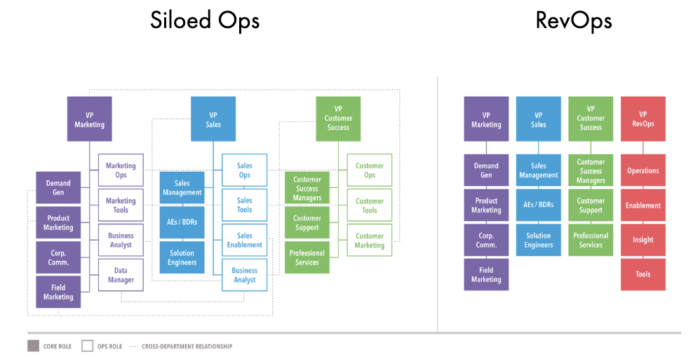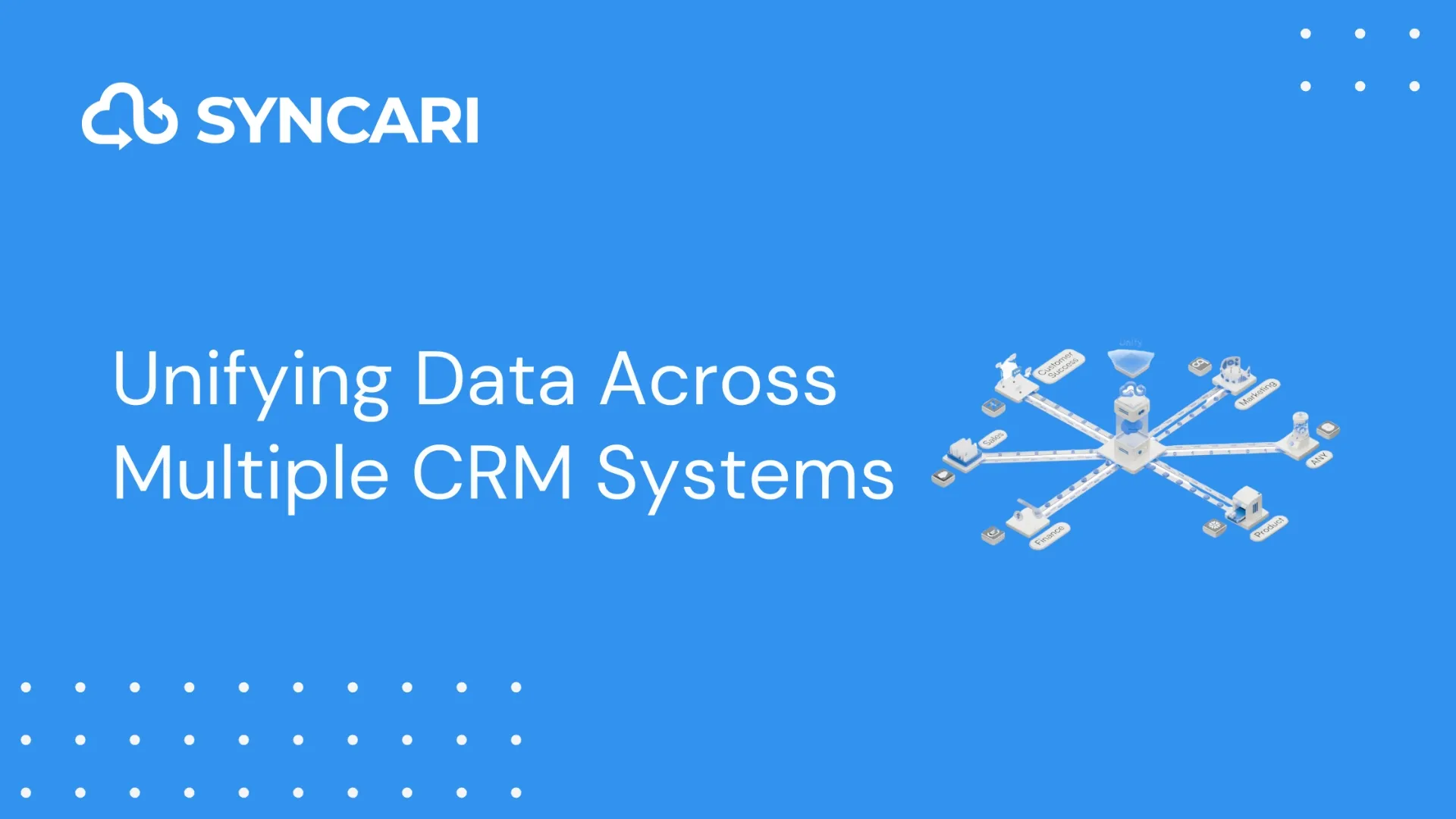Revenue Operations (RevOps) is the new kid in school. Many of us (including those who were recently called “sales operations” or “marketing operations”) are peering into the classroom wondering what all the fuss is about. In this article, I’ll aim to put the rumors to rest and demystify B2B’s new key to revenue generation and aligned teams.
What is revenue operations?
RevOps is the team responsible for efficient go-to-market teams. Namely, sales, marketing, customer success and even finance rely on revenue operations to align their data, support their processes and tools, and report on key metrics.
RevOps teams often include or work closely with marketing operations, sales operations, CS operations, and finance operations.
Tools used by RevOps teams
RevOps teams work with a variety of tools. Here are some examples.
- CRM (Salesforce, HubSpot, Zoho, Dynamics, SAP)
- Marketing Automation (HubSpot, Marketo, Pardot)
- Data Enrichment (ZoomInfo, Demandbase, Clearbit)
- Sales Engagement (Outreach, Salesloft)
- Support (Jira, Zendesk, Intercom, Gainsight)
- Billing/ERP (Chargebee, Stripe, NetSuite, Dynamics)
- Data Warehousing (Snowflake, Redshift, BigQuery)
Revenue operations teams are responsible for ensuring data across these systems is accurate and unified, so the teams using those tools can operate efficiently.
We’ll dive deeper into the definition of revenue operations later in this article. But for now, let’s start with the origins of RevOps and what makes this team so unique. Is it just a new organizational hierarchy? Or could it be the solution to your silos and data chaos? Then I’ll see if the RevOps approach is right for you and give you some tools to get started in your own organization.
[ Related: How to Build a Resilient Ops Team with the VP of RevOps at Uberflip ]
The nebulous origins of RevOps and why we needed it ten years ago
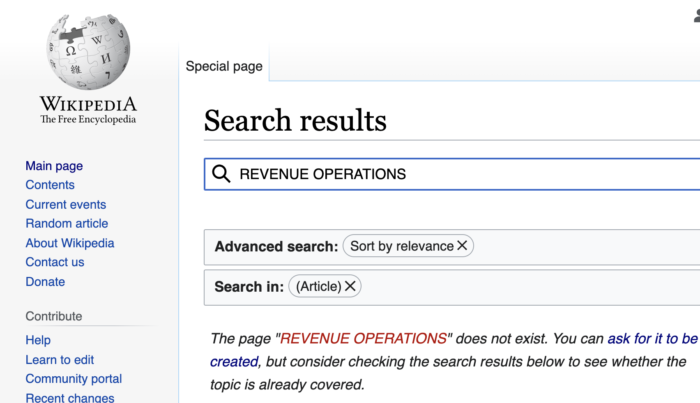
The history of RevOps is a short one.
It may come as a surprise to some that the etymology of the term ‘revenue operations’ is slippery at best. But no single organization or ‘thought leader’ coined it. In some capacity, there was always someone scrambling to keep sales, marketing, and back office teams aligned — whether called business systems or just ‘IT.’
The emergence of the RevOps approach began with B2B research firms theorizing fixes to misaligned teams across the revenue funnel. It was then later popularized by early adopters of the new ‘Chief Revenue Officer’ title in the early 2010s.
Subscription-based businesses saw the vision of a RevOps team and after 2014, there was an explosion in popularity. Today, countless Slack groups, podcasts, LinkedIn influencers, and blogs speak to its increasing importance in B2B.
A closer look into the origin of RevOps and its creation
Revenue Operations, or RevOps (as stated above), is a relatively new concept that emerged as a result of the ever changing landscape of sales and marketing. Overall, RevOps is a strategic approach that companies take to managing their revenue and essentially focuses on aligning sales, marketing, and customer success teams to achieve the best results possible. (Or at least better revenue results than they currently have).
You can trace the history of RevOps all the way back to the early days of the internet. This is when businesses began moving their operations online.
So, as e-commerce became more widespread and prevalent, companies realized that they needed to adapt their business to the digital realm — specifically their sales and marketing strategies. This led to the creation of new job roles (e.g. digital marketers, sales enablement specialists) whose main goal is to navigate (and achieve) online sales.
However, as the number of sales/marketing channels and platforms multiplied, traditional silos between these once separate departments were no longer as effective. With that said, a new role emerged: the revenue operations professional. This person is responsible for bridging the gap between sales, marketing, and customer success teams, as well as ensuring everyone is working towards a common goal.
The term “RevOps” was coined by LeanData CEO, Evan Liang, in 2016. At the time, Liang was working with a team of sales and marketing professionals who struggled to align their efforts. He realized the need for a new approach to revenue management — one that focused on collaboration and data-driven decision making. This led to the creation of the RevOps model, which is now a very popular framework for businesses looking to improve their revenue performance.
Today, RevOps is a fast-growing field that businesses of all sizes are quickly embracing.
So, when companies adopt a RevOps approach, they’ll benefit from better alignment between sales, marketing, and customer success teams. They’ll also see improvements in data analysis and reporting, and more efficient (and cost-effective) use of resources. RevOps will likely continue to play a key role in helping companies stay competitive and achieve their revenue goals — even as the business world continues to evolve.
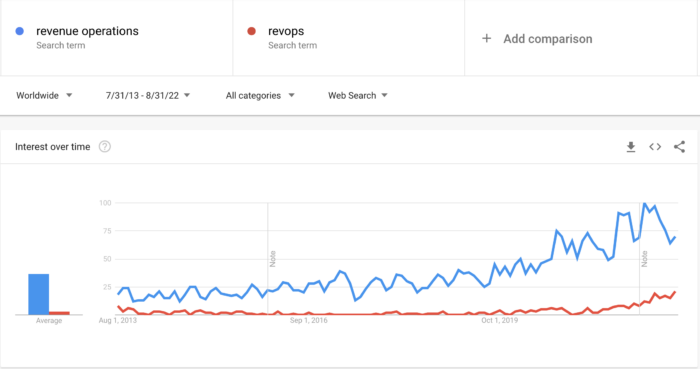
The road to RevOps has never been straight and narrow.
But popularity doesn’t guarantee quality — just look at the state of pop music. Is the RevOps frenzy merely our B2B Justin Bieber? We don’t think so. We see RevOps is to B2B as Billie Eilish is to pop music — a breath of fresh air, a unifying force, a merging of the old and the new. But before we get to the juicy stuff, let’s start with the why.
What necessitated the birth of the RevOps methodology?
First, customers changed.
Buyers increasingly came to sales calls having researched their options and compared competitors. As a result, the conversations shifted from closing to cultivating. How could sales cultivate relationships and solve the buyer’s problems as opposed to just selling? Our outdated systems and silos were ill-equipped to adapt to a buyer who expected a seamless customer journey.
But we didn’t just need to adapt our sales tactics. An increase in customer data meant there was no shortage of emerging applications to organize it.
SaaS businesses were drowning in aging software, inaccurate data, and horrific handoffs from department to department. How do we begin to report on the future of revenue growth with overlapping tech stacks and unaligned goals? As data needs grew, the need to tame it and bend it to our will grew, too.
RevOps emerged as a methodology for solving the customer’s needs while optimizing every area that touches revenue generation.
Revenue operations defined
Revenue operations is not just a title or organizational structure. It’s a methodology — a way of thinking — that helps a company optimize all the touches of their unique customer journey with the goal of increasing revenue. RevOps people move the people, processes, and tools within that for maximum coordination.
Think about the RevOps approach like you would a train ride. To get passengers from place to place, all areas of the station need to be running smoothly. RevOps coordinates and optimizes every stage of that journey. From the destination advertisements (marketing) and the processing and purchase of a ticket (sales) to the onboard experience (customer success), and ensuring all locomotive infrastructure is in working order (systems).
RevOps strategically balances the needs of the customer and the alignment of all departments so they’re working in harmony towards revenue generation.
Now, this may sound familiar. But fear not, revenue operations is not sales ops by another name. A head of sales ops may say something like:
We’re not getting enough meetings which means we’re not self-generating enough pipeline.
Whereas a head of revenue operations has a wide-angle lens aimed at the pipeline. This allows them to diagnose pain points and increase efficiency. They would look at the same problems and say:
We’re not getting enough meetings which means we’re not self-generating enough pipeline. Maybe that’s because we’re not making enough calls against the leads that marketing is spending money on, so we’re not leveraging the software we’re using and getting the ROI on those.
The RevOps team removes departmental silos by unifying all teams under an aligned go-to-market (GTM) strategy and end-to-end processes of driving revenue growth. This is not a regular Ops meeting to chip at walls between sales and marketing. This is a full-scale remodeling that optimizes all the customer-facing teams of your organization.
The four pillars of RevOps alignment
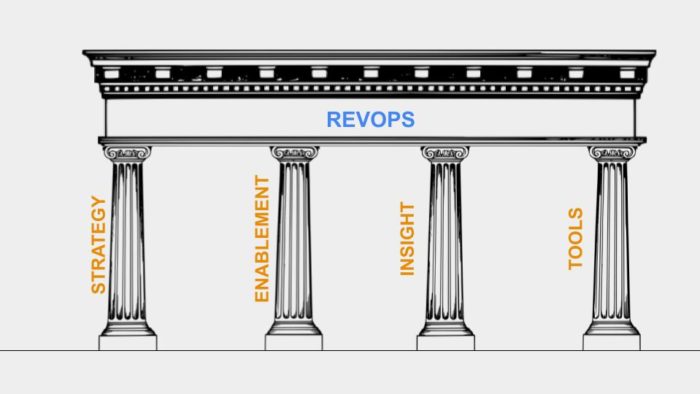
The role of a Revenue Operations team is to align your revenue generation across all GTM teams. The success of a RevOps team depends on their ability to act on four pillars:
1. Strategy
Teams in the same organization often feel like they’re working on different planets — communication gets lost in deep space, handoffs result in weak leads, and there’s poor upstream feedback. A RevOps professional aptly described a time when marketing and sales were misaligned and chaos ensued:
“We literally did not know who was on the marketing team or what building they were in. Randomly, every few months, they’d dump 2,000 leads into each of our CRM and they’d all be 1-800 numbers and not real companies, and we’d go, ‘Who are these marketers and why do they make my life so tough?’ Because our system was so clunky, it was easier for me to reassign those bad leads to my boss, who never went into the CRM, than it was to delete them. To delete them I had to answer a bunch of questions, and with 2,000 leads, there was no way to do my job AND deal with them.”
A Head of Revenue Operations aligns tricky process gaps by taking a birds-eye view of operations to optimize and grow with the bigger picture in mind. It’s the RevOps team’s job to find opportunities to ease finance processes, find more efficient connections between marketing and sales, and detect and correct pain points. If there is money left on the table, if we need to rethink pricing, if we need to plan for the future, your RevOps team is there to strategize with the knowledge you need.
2. Enablement
The RevOps team is there to enable all areas of the organization to run smoothly. They’re onboarding and training staff on the tech stack. Offering coaching and professional development for the marketing team. RevOps leads are spearheading project and change management and creating processes that encourage collaboration between sales, marketing, and customer success. By enabling your GTM teams to shift their focus from operations to their customer-facing tasks, you’re freeing them up to continue to do great things. The RevOps methodology is a success when operations enable other teams to achieve their goals.
3. Insight
RevOps people measure and analyze your most important resources—your customer data. Finding friction across the funnel and solving your persistent data woes is what the RevOps team was created for. Do you need to identify, predict and reduce customer churn? Your RevOps team can help. How about measuring and analyzing KPIs like forecast accuracy, cost of customer acquisition, and renewals and upsells? RevOps can handle it. How about using that data to align all teams on a united strategy to drive revenue growth? The RevOps team is your new secret weapon.
4. Tools
When Mollie Bodensteiner started her RevOps position at Granular and inherited 40 to 50 systems, she asked the question: Do we need all these? All four pillars of RevOps alignment hinge on how well your RevOps team can manage your tech stack. Data management and access are key to RevOps alignment. They take the guesswork out of tools so your teams aren’t worried about permission or system updates. From evaluation, procurement, and integration of tech with existing systems to ongoing administration, RevOps people optimize your tech stack to make sure no e-stone is left unturned in the road to revenue growth.
[ Related: How Data Professionals Can Excel in Revenue Operations (RevOps) ]
Are your teams ready for the RevOps culture shift?
The reason the RevOps approach is not just an organizational structure or new C-suite title is that the four operational pillars above fall apart quickly without a collaborative culture to reinforce it. It’s not enough to name a CRO and expect organizational alignment. In order to see success, your teams need to be ready for potentially big changes. Take a deep breath and answer the questions below — self-reflection is encouraged.
Are you ready for optimization?
Nothing is sacred and ROI is everything. The RevOps team’s job is to look at everything through the lens of optimization and make processes smoother. Now, that may be painful when trimming the tech stack inconveniences your teams or requires them to learn a new data entry process. But consider the alternative world of overlapping tech permissions, erased data, and constant power struggles. Give RevOps geniuses the power to optimize at every level of the funnel and watch things get done right and faster than before.
Are you ready for coordination?
Your CRO lays the tracks to keep the trains running. It would be a mistake to see RevOps people as a threat to leadership or culture. They free up departments to focus on customers by coordinating internal operational needs. They are continually working for the good of marketing, technology, sales, and customer service while keeping everyone’s priorities and goals aligned. We’ve seen what happens when we’re optimizing within silos. We set uninformed goals for marketing’s leads, they hand off low-quality prospects and screw over sales goals. Or sales focuses on selling over solving the customer’s problems, leaving customer success scrambling as retention falls. Is your team ready to move out of silos into a brave new world of collaboration? It requires trusting that your CRO is strategically balancing the needs of the customer and the alignment of all departments so everyone is always on the same track.
Are you ready for transparency?
The marketing team at an industry-leading MarTech company tried out account-based and went knocking on sales’ doors for all their best accounts. But an AE was wary, “I didn’t trust marketing, I suspected they’d simply spam my accounts and burn all the bridges. So I lied and gave them sub-par ones.” It’s a tale as old as time—poor communication and competing priorities breeds a culture of protectionism. As the RevOps pillars shore up each department, the infighting is replaced with transparency. Now, instead of uninformed decisions based on misaligned data, the RevOps team is responsible for your sources of truth and ensures everyone has the information they need to make defensible strategic decisions. This is how you build trust and break walls for good.
Are you ready for growth and adaptability?
When your teams are aligned, optimized for revenue generation, and working together to maintain a seamless customer journey, growth should be expected. The RevOps team’s grasp of your data means that sustainable growth can be anticipated well in advance. Your GTM teams can be prepared for feast or famine—adaptable because their process and systems are in good hands. Executives have the data and recommendations they need to plan for the future and envision long-term moves. If your teams want to better adapt to market changes or launch new offerings, the RevOps approach could help you achieve the growth you’ve been searching for.
Revenue Operations team structure
Traditional team hierarchy vs. RevOps approach
If you’ve gotten this far, you are probably serious about forming a RevOps team.
Who should revenue operations report to?
More and more debates are popping up about where RevOps should report, such as this survey from David Kirkdorffer. This suggests most people believe RevOps should report to Sales.
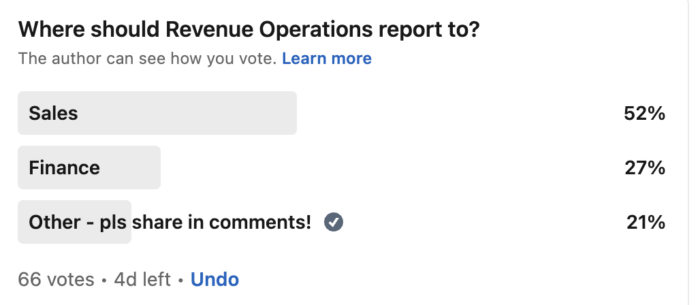
To create a revenue operations organization, and to hire effectively for RevOps roles, most businesses choose to hire or appoint a Chief Revenue Officer to shift all operations under the umbrella of RevOps. CROs tend to lead sales organizations, which fits with the majority respondents to the survey above.
It’s important that the CRO or head of RevOps does not report to Sales or Marketing heads. This is to ensure they can review all areas without bias and get buy-in from all departments. Trust and transparency is the key to getting everyone on the same track. Remember, this is a culture shift, not a new org chart.
If your organization is large enough to need the RevOps approach but small enough that a CRO isn’t feasible, your leads can start by sharing responsibilities under the RevOps pillars — with the expectation that RevOps will one day become its own department.
But at Syncari, we believe RevOps is an executive function, reporting to the CEO, COO or President. Anything else will likely convey bias and, as a result, potential abuse or mistrust.
[ Related: Syncari Named a 2022 Gartner® Cool Vendor™ in RevOps Data Automation ]
How to create a RevOps function
Organizational alignment, revenue growth, and data peace are within your grasp with the guidance of smart RevOps professionals. Here, I’ve included a brief process below to begin planning your organization’s RevOps journey:
1. Audit
- Firstly, review our customer journey and find the disconnect between departments
- Now is the time to ask the difficult questions:
- Are we leaving money on the table? Where is the pipeline leaking?
- Where are our process gaps? Handoff issues?
- Are all client-facing teams aligned on their goals? How are we working against one another?
- Do we trust our data? Is it in the hands of those who need it? Is it accurate?
- How are our tools integrated? Do we have a single source of truth?
- Are we growing rapidly? How are we training/onboarding/developing our talent?
- Are our systems aging? How can we consolidate our tech stack?
2. Define and align
- Create a RevOps strategy to lead the initial shift towards the RevOps approach.
- Evaluate our revenue pipeline and how we can improve it. Begin to recognize the pain points throughout the processes and how we can streamline across departments.
- Discover tech redundancies and offer solutions and consolidating options. Be open to new systems.
- Align all teams under RevOps processes. Get buy-in and choose to prioritize transparency and trust.
3. Build
- Create our GTM plan for customer acquisition and customer success.
- Build collaborative workflows to move prospects through and ensure data is accurate.
- Build sales resources and tasks. Test and refine, as needed.
- Optimize tech dashboard that shows distributed truth across all teams. Syncari provides a distributed source of data truth for greater data agility across all your top systems, no matter how complex the integrations or tech stack.
4. Activate and optimize
- Book and prioritize regular RevOps meetings with heads of GTM teams to stay aligned and coordinate all areas.
- Create a long-term plan to regularly update RevOps strategy to reflect revenue growth and organizational change.
Congratulations, you’ve begun your RevOps journey. Whether that means you’re a bit more informed about this holistic approach to revenue growth or ready to build out your own RevOps team. Businesses are achieving their revenue goals with more organizational harmony than ever before. Why not jump on the RevOps train?
